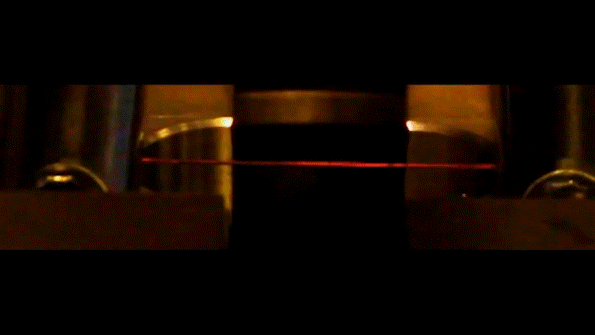Colour-changing fibres indicate pressure in compression bandages

FIBRES that change colour when stretched have been integrated into compression bandages, which will allow the correct pressure to be applied to injuries.
Compression therapy is frequently used to treat conditions such as venous ulcers. However the correct pressure range is quite small and there is no way to know for certain if the correct pressure has been applied. If the wrong amount of pressure is used, it can prolong treatment or potentially result in further injury. Currently, methods for attempting to restrict the pressure range include pressure-limiting textiles, which can be difficult to use at high strains. Another alternative is to put thin pressure sensors under the bandage, but they only provide information for specific areas and could affect the applied pressure.
A new type of compression bandage has been developed that incorporates a stretchable pressure-sensitive photonic fibre. When the bandage is stretched, the fibre changes colour and the colour can be matched to the desired pressure.
"Getting the pressure right is critical in treating many medical conditions including venous ulcers, which affect several hundred thousand patients in the US each year," said Mathias Kolle, assistant professor of mechanical engineering at MIT. "These fibres can provide information about the pressure that the bandage exerts."
The fibre is made up of alternating thin layers of transparent rubber materials which are wrapped around a stretchable core filament. The layers reflect visible light over a narrow spectral range and the central wavelength of the fibre is shifted to a lower wavelength (blueshifted) with increasing strain. In the study, the fibre was manufactured to be yellow at the correct pressure range because yellow has the narrowest bandwidth of any colour in the visible spectrum, thus giving better precision. The colour then changed to green and then blue as the fibre was stretched.

However, it is possible to design the fibres so that it is redshifted when stretched, meaning that the red colour could be used as a warning when the compression bandage is too tight.
"If you want a fibre to go from yellow to green, or blue, we can say, 'This is how we have to lay out the fibre to give us this kind of [colour] trajectory,'" said Kolle. "This is powerful because you might want to have something that reflects red to show a dangerously high strain, or green for 'ok.' We have that capacity."
The fibre was tested over 10,000 cycles of stretching and relaxation and reflected colours remained the same, showing the durability of the fibre. "You can get brighter, stronger colours than with inks or dyes just by using particular arrangements of transparent materials," said Joseph Sandt, a graduate student at MIT. "These colours persist as long as the structure is maintained."
The bandage was also tested with a group of volunteers with no medical experience to see if they could apply the bandages at the correct pressure range. They were given an ordinary compression bandage, one where pressure is indicated by a rectangle being deformed into a square, and the colour-changing bandage. Of the three, the colour-changing bandage was applied at the correct pressure range more accurately than with the others.
The researchers are currently working on scaling up the process, as the fibres are only a few centimetres long. "Currently, the fibres are costly, mostly because of the labour that goes into making them," said Kolle. "The materials themselves are not worth much. If we could reel out kilometres of these fibres with relatively little work, then they would be dirt cheap."
Advanced Healthcare Materials http://doi.org/gdmt98
Recent Editions
Catch up on the latest news, views and jobs from The Chemical Engineer. Below are the four latest issues. View a wider selection of the archive from within the Magazine section of this site.




